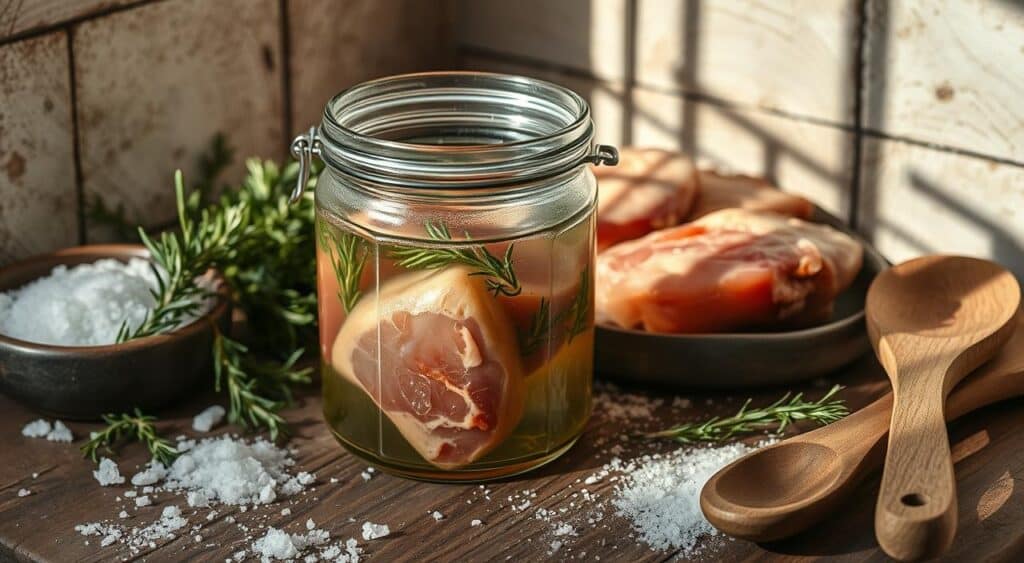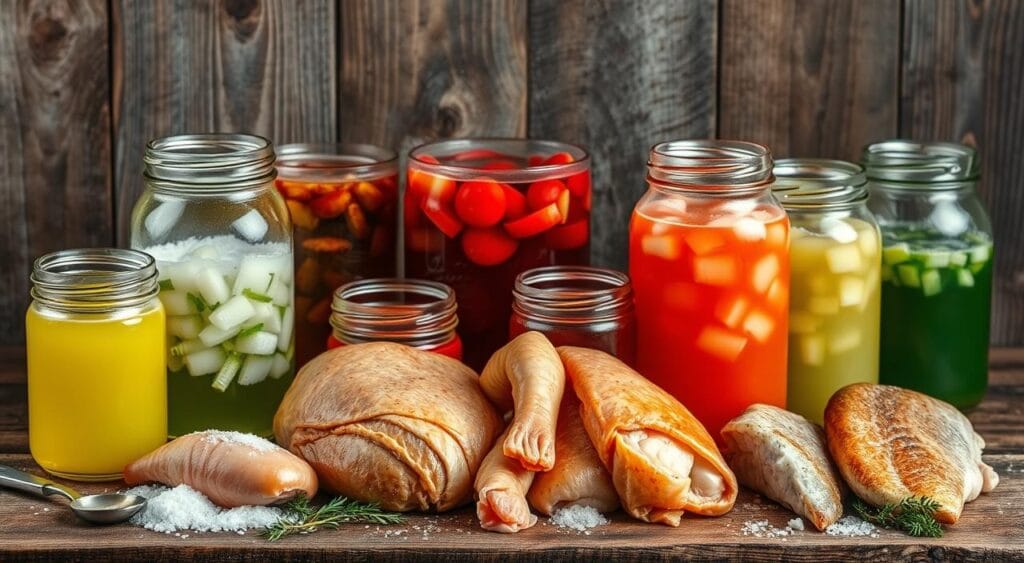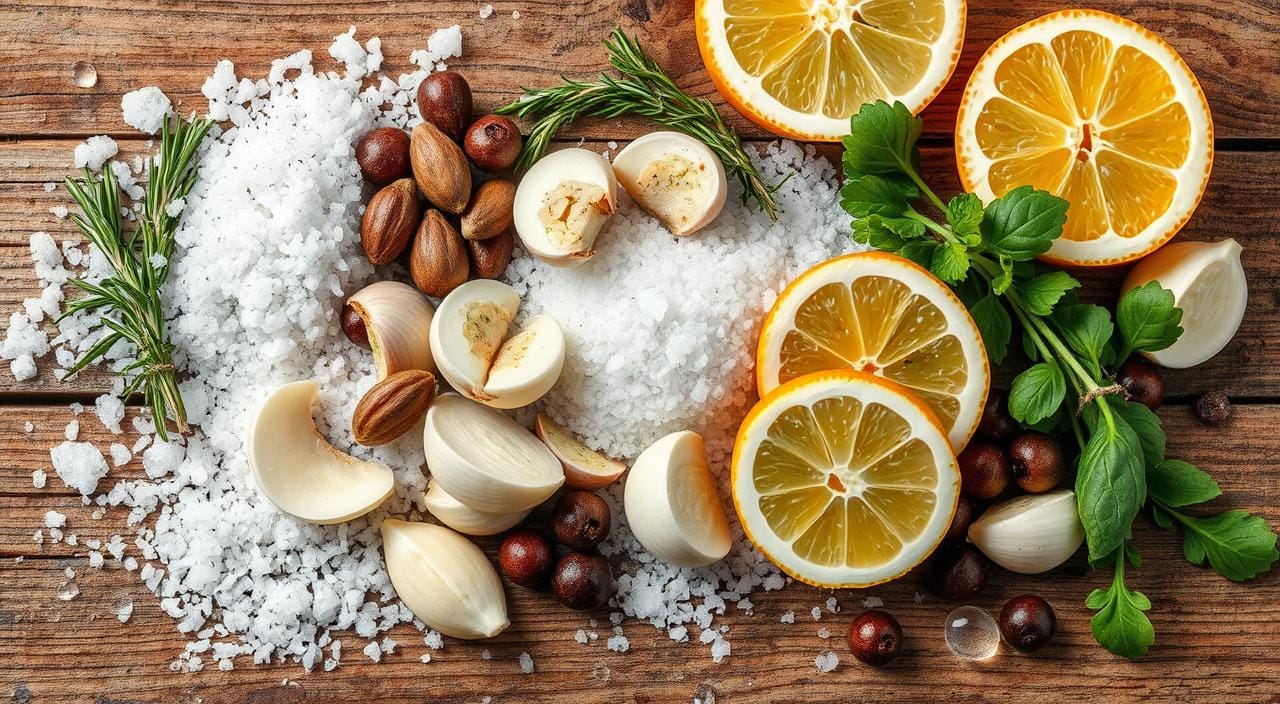Jump to:
Brining is key for juicy, flavorful meats. Finding the right mix of salt and sugar in the brine is crucial. The right balance boosts moisture, tenderness, and taste. This article will dive into the science of brining, share standard ratios for meats, and give tips for customizing your brine.
Key Takeaways
- Brining can reduce moisture loss during cooking by up to 50%.
- Brine solutions typically consist of 5-20% salt, depending on the purpose.
- The ideal brine ratio for poultry is around 3% salt solution.
- Brining times vary based on the type of meat or seafood being brined.
- Customizing brine with aromatics and herbs can enhance flavor profiles.
Introduction
Brining is a simple yet powerful technique that can transform the texture and flavor of meats. By soaking proteins in a saltwater solution, the brine is absorbed into the muscle fibers. This results in juicier, more tender, and better-seasoned results. However, getting the right balance of salt and sugar in the brine is crucial for achieving the perfect outcome.
In this comprehensive guide, we’ll dive into the science behind brining. We’ll share standard ratios for various meats and provide tips on customizing your brine. Whether you’re brining poultry, pork, beef, or seafood, understanding the role of salt and sugar is key. It unlocks mouthwatering, flavorful results.
“Brining is a simple yet powerful technique that can transform the texture and flavor of meats.”

Brining is a popular food preservation method. It enhances the taste and texture of proteins and helps extend their shelf life. By immersing meats in a saltwater solution, the brine penetrates the muscle fibers. This increases their moisture content and seasons them from the inside out.
This process, known as osmosis, also helps denature the proteins. This results in a more tender and juicy final product. But the true secret to successful brining lies in striking the right balance between salt and sugar. The salt in the brine helps to draw out moisture from the meat. The sugar adds a subtle sweetness and aids in caramelization during cooking.
Understanding the Role of Salt and Sugar in Brining
Salt and sugar work together in brining to make meat juicier and more flavorful. Salt dissolves proteins, letting the brine soak into the meat. This helps the meat stay moist while cooking.
Why Salt is Essential in Brining
Salt is key in brining because it changes the meat’s texture and keeps it moist. You need at least 3/4 cup of Kosher salt for every gallon of water to brine effectively.
How Sugar Enhances Flavor and Tenderness
Sugar adds to the meat’s flavor and tenderness by denaturing proteins and improving browning. Adding 2 tablespoons of brown or white sugar to the brine can greatly enhance the meat’s taste.
The Science Behind the Perfect Brine Salt Sugar Ratio
The right mix of salt and sugar in the brine makes meat juicier and more flavorful. Brining changes the meat’s protein structure, trapping water and enhancing flavor.

“Brining is a powerful technique that can transform the texture and flavor of meats, making them juicier and more delicious.”
Standard Brine Salt Sugar Ratios for Different Meats
Brining needs the right salt and sugar mix for each meat. Knowing these ratios is key for juicy, tasty results every time.
The Ideal Ratio for Poultry
For poultry, start with 1/2 cup of salt and 1/4 cup of sugar in 1 gallon of water. This mix seasons the meat well and makes it tender and juicy. Brining poultry is great for drier cuts like chicken breasts.
Brine Ratios for Pork and Beef
Pork and beef need a bit more salt in their brine. Use 3/4 cup of salt and 1/4 cup of sugar per gallon. This makes the meat tender and flavorful.
How Much Salt and Sugar for Fish and Seafood
Fish and seafood need a lighter brine. Aim for 1/4 cup of salt and 2 tablespoons of sugar per gallon. This balances flavor without making it too salty.
| Meat Type | Salt Ratio | Sugar Ratio |
|---|---|---|
| Poultry | 1/2 cup per gallon | 1/4 cup per gallon |
| Pork and Beef | 3/4 cup per gallon | 1/4 cup per gallon |
| Fish and Seafood | 1/4 cup per gallon | 2 tablespoons per gallon |

“Brining is a simple yet essential technique that can transform even the most basic cuts of meat into something truly extraordinary.”
How to Adjust the Brine Salt Sugar Ratio Based on Cooking Methods
Brining involves adjusting the salt and sugar ratio for different cooking methods. This fine-tuning helps achieve the perfect texture and flavor. Whether grilling, roasting, frying, smoking, or sous vide, the right balance is key.
Grilling and Roasting Brine Ratios
For grilling and roasting, use a bit more sugar. Aim for 1/3 cup of sugar for every 1 cup of salt. This enhances browning and caramelization on the meat’s surface. It creates a golden-brown crust while keeping the inside juicy.
Brine Ratios for Frying or Smoking Meat
For frying or smoking, increase the salt ratio. Use 3/4 cup of salt for every 1/4 cup of sugar. This higher salt helps keep the meat moist and prevents it from drying out.
Adjusting Ratios for Sous Vide Cooking
For sous vide, the ratio is slightly different. Use 1/2 cup of salt and 1/4 cup of sugar per gallon. This ensures the meat stays tender and flavorful without being too salty.
“The key to a perfect brine is understanding how to balance the salt and sugar ratios to complement the specific cooking method you’ll be using.”
Common Mistakes When Using the Brine Salt Sugar Ratio
Getting the right mix of salt and sugar in a brine is key for juicy, tasty meat. But, it’s easy to mess up. Mistakes like over-salting or under-salting the brine or using too much or too little sugar can ruin the dish.
Over-Salting or Under-Salting the Brine
Too much salt makes the dish too salty and unappetizing. Not enough salt means the meat won’t taste as good. Use about 1/4 cup of kosher salt per quart of liquid or 2 tablespoons of table salt per quart. This ensures the right flavor and texture.
Using Too Much or Too Little Sugar
Too much sugar makes the brine too sweet and syrupy. Not enough sugar means the meat won’t be as tender or caramelized. Aim for about 2 tablespoons of sugar per quart of brine to balance the salt.
Not Dissolving Salt and Sugar Properly
It’s important to make sure the salt and sugar dissolve fully in the water before adding the meat. Undissolved crystals can cause uneven seasoning and a gritty texture. Always dissolve the brine ingredients well before adding the meat.
By avoiding these mistakes and watching the salt and sugar levels, you can make perfectly seasoned, juicy, and flavorful meat every time. [https://jennierecipes.com/best-barbecue-seasoning-recipe/]
Customizing Your Brine Salt Sugar Ratio
Starting with standard brine ratios is a good first step. But you can tweak the salt and sugar levels or add flavors. Adding aromatics and herbs brings extra taste to your meat. For less sodium, try low-sodium brining options like pink Himalayan salt or sea salt. More sugar makes a sweet brine, while more salt makes it savory.
Adding Aromatics and Herbs for Flavor
Garlic, onions, and fresh herbs can make your meat taste better. Try mixing rosemary, thyme, and garlic, or fennel, coriander, and lemon zest. These combinations add a nice flavor.
Low-Sodium Brining Options
For a low-sodium diet, use less traditional table salt. Pink Himalayan salt or sea salt are good alternatives. You can also add soy sauce or Worcestershire sauce for flavor without extra salt.
Creating a Sweet or Savory Brine Mix
Changing the salt and sugar ratio changes the taste. A sweet brine with more sugar is great for poultry or pork. A savory brine with more salt is better for beef or game meats.
| Brine Type | Salt to Sugar Ratio | Best Suited for |
|---|---|---|
| Sweet Brine | 1 part salt to 2 parts sugar | Poultry, Pork |
| Savory Brine | 2 parts salt to 1 part sugar | Beef, Game Meats |
“Brining is an essential technique for achieving juicy, flavorful meat. By customizing the salt and sugar ratios, along with adding aromatic ingredients, you can create a brine that perfectly complements your chosen protein.”
Nutritional Considerations of the Brine Salt Sugar Ratio
Brining can make meats taste better and feel softer. But, it’s key to think about the salt content in brine and sugar content in brine and their health effects. Too much salt can lead to high blood pressure. Too much sugar might not fit with your diet or health goals.
How Salt Levels Impact Nutrition
For dry salting, use about 1 tablespoon of salt for every 1 1/2 pounds of meat. Brining uses a stronger mix: 4 tablespoons of salt for 4 cups of water. But, the best brine mix is between 1.5% and 5%, with 2-3% being ideal.
Managing Sugar Content in Brined Meat
Sugar can make brined meat taste better and feel softer. But, it’s important to watch the sugar content in brine. If you’re on a low-sugar diet or have health concerns, adjust the sugar in the brine carefully.
Healthier Brining Alternatives for Low-Sodium and Low-Sugar Diets
To deal with high salt content in brine and sugar content in brine, try low-sodium brine and low-sugar brine options. Use low-sodium salts, cut down on salt and sugar, or try new brining ways. Use herbs, spices, and acids for flavor without salt and sugar.
FAQ: Brine Salt Sugar Ratio
Getting the right brine salt and sugar ratio is key for juicy, tasty meats. Here are some common questions about this important topic:
What is the standard brine ratio for different meats?
The basic brine ratio is 1 gallon of water, 1 cup of kosher salt, and 1 cup of sugar. You can adjust this for different meats:
- Poultry: 1 cup salt, 1/2 cup sugar per gallon of water
- Pork and beef: 3/4 cup salt, 1/2 cup sugar per gallon of water
- Fish and seafood: 1/2 cup salt, 1/4 cup sugar per gallon of water
How do I adjust the brine ratio for different cooking methods?
You can change the brine ratio for different cooking ways:
- Grilling and roasting: Add 1/4 cup more salt per gallon of water
- Frying or smoking: Use 1/4 cup less salt per gallon of water
- Sous vide: Use 1/2 cup less salt per gallon of water
What are the common mistakes when using the brine ratio?
Common errors include over-salting, using too much or too little sugar, and not dissolving the salt and sugar well. It’s crucial to stick to the right ratios and dissolve everything fully for the best taste.
By knowing the brine salt and sugar ratio, you can make meats that are both juicy and flavorful. Don’t be afraid to try different ratios and adjust them for your taste and cooking methods. This will help you achieve amazing results.
Conclusion: Achieving the Perfect Brine Salt Sugar Ratio for Tender, Flavorful Meat
Learning the brine salt and sugar ratio is key to making brining meat and brining poultry work. It’s about understanding the science behind this food preservation method. This knowledge helps you make your meat tender, juicy, and delicious.
Don’t be afraid to try different ratios for your taste. Whether you’re grilling, roasting, or frying, adjusting the salt and sugar balance matters. Also, think about how your seasoning brines affect your health. You might want to lower sodium or sugar.
By following these tips, you can make your meat taste like it’s from a restaurant. So, dive into the science, experiment with flavors, and find the ideal brine salt sugar ratio. This will give you the tender, juicy, and flavorful meats you love.
FAQ
What is the standard ratio of salt and sugar for brining poultry?
For poultry, start with 1/2 cup of salt and 1/4 cup of sugar for every 1 gallon of water.
What about the ideal brine ratio for pork and beef?
Pork and beef need a bit more salt. Use 3/4 cup of salt and 1/4 cup of sugar per gallon.
How much salt and sugar should I use for brining fish and seafood?
For fish and seafood, use 1/4 cup of salt and 2 tablespoons of sugar per gallon. This helps avoid over-salting.
How can I adjust the brine ratio for different cooking methods?
For grilling and roasting, add more sugar, about 1/3 cup for every 1 cup of salt. This enhances browning. For frying or smoking, increase salt to 3/4 cup for every 1/4 cup of sugar. This counteracts drying. For sous vide, use 1/2 cup of salt and 1/4 cup of sugar per gallon.
What are some common mistakes to avoid when using the brine salt and sugar ratio?
Avoid over-salting the brine to prevent an overly salty dish. Also, don’t add too much sugar, as it can make the texture syrupy. Make sure the salt and sugar dissolve fully in the water before adding the meat for consistent results.
Can I customize the brine salt and sugar ratio?
Yes, you can customize your brine. Adjust the salt and sugar levels or add flavors like garlic, onions, and herbs. You can also try reducing salt or using low-sodium options, or add more sugar for sweetness.
How do I address nutritional concerns with the brine salt and sugar ratio?
To lower salt intake, use low-sodium salts or reduce salt and sugar amounts. You can also try brining with herbs, spices, and acidic ingredients for flavor without salt and sugar.






